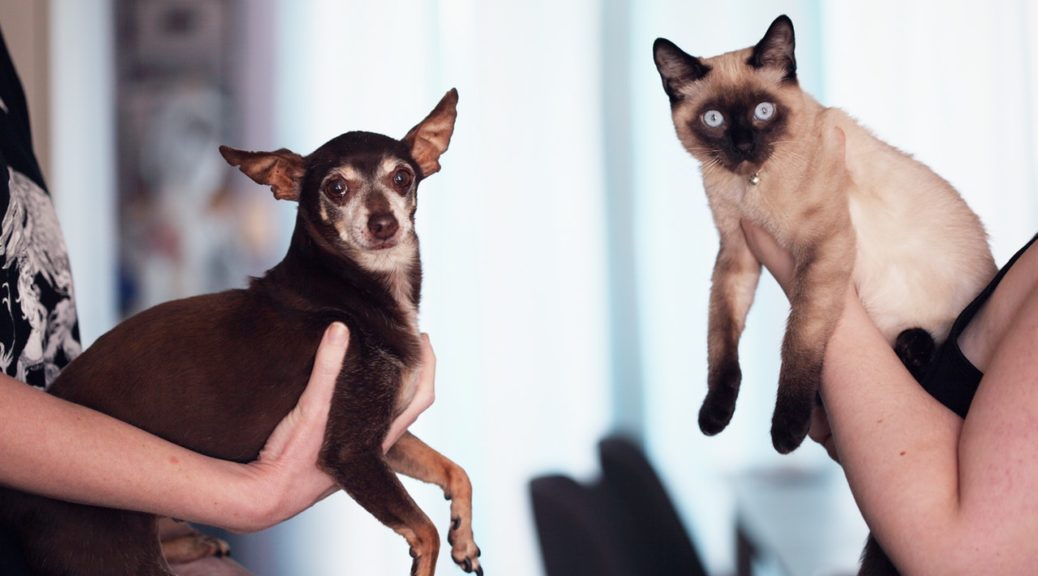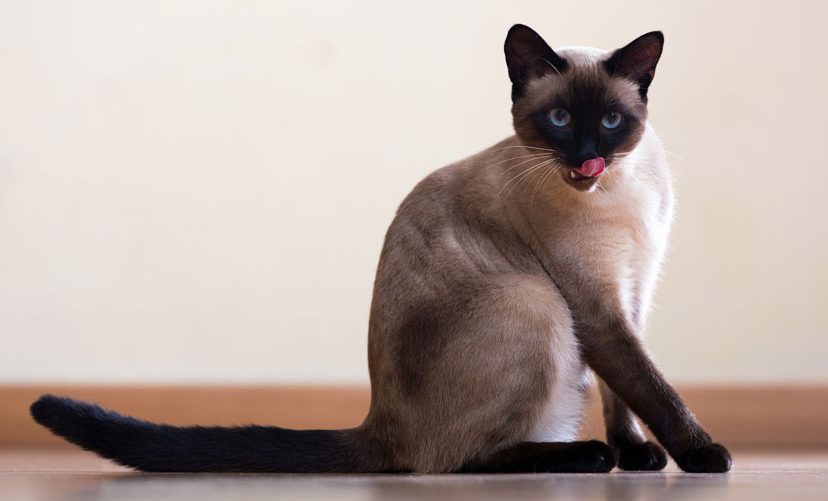Contents
- I. Introduction
- II. Understanding Siamese Cats
- III. The Nature of Siamese Cats
- IV. Do Siamese Cats Get Along With Other Cats?
- V. Factors That Influence Siamese Cats’ Relationships With Other Cats
- VI. Introducing a Siamese Cat to Other Cats
- VII. Signs of Compatibility Between Siamese Cats and Other Cats
- VIII. Frequently Asked Questions about Siamese Cats’ Relationships with Other Cats
I. Introduction

Siamese cats are known for their striking appearance and unique personality. With their beautiful blue eyes, sleek coats, and distinctive color points, they easily capture the hearts of cat lovers around the world. But if you already have other cats in your household, you may wonder if a Siamese cat would get along with them. In this article, we will explore the social nature of Siamese cats and their compatibility with other feline companions.
Understanding the Siamese Cat’s Personality
Siamese cats are highly social and affectionate creatures. They crave human interaction and enjoy being part of a family. Their extroverted nature often makes them excellent companions for both humans and other cats. Siamese cats are known to be vocal and will often engage in conversations with their owners, demanding attention and affection.
Introducing a Siamese Cat to Your Existing Feline Friends
When introducing a Siamese cat to your other cats, it’s important to take a gradual approach. Start by allowing them to sniff each other’s scent under a door or through a barrier. This helps them become familiar with each other without direct contact. Once they seem comfortable with the scent, you can proceed with supervised face-to-face introductions in a neutral space.
Monitoring the Interaction
During the initial interactions, keep a close eye on the cats’ body language and behavior. Some hissing, growling, or swatting is normal as they establish hierarchy and boundaries. However, if the aggression escalates or becomes prolonged, it may be necessary to separate them and seek professional guidance from a veterinarian or animal behaviorist.
Creating a Harmonious Environment
To promote harmony between your Siamese cat and other feline companions, ensure that each cat has enough personal space, resources, and attention. Provide multiple litter boxes, food bowls, and resting areas throughout your home. Engage in interactive play sessions with each cat individually to prevent competition for attention.
Time and Patience
It’s important to remember that every cat is unique, and the time required for successful integration can vary. Some Siamese cats may quickly establish friendships with other cats, while others may need more time to adjust. Patience and understanding are key in allowing them to form their own bonds at their own pace.
In conclusion, Siamese cats can indeed get along with other cats. Their sociable nature and adaptability make them great candidates for multi-cat households. By following a careful introduction process and providing a harmonious environment, you can increase the chances of a successful and peaceful coexistence between your Siamese cat and their feline companions.
II. Understanding Siamese Cats
Siamese cats are known for their striking appearance and unique personalities. In this section, we will delve into the characteristics and behavior of Siamese cats, shedding light on what makes them so special.
1. Distinct Physical Features
Siamese cats are easily recognizable due to their distinct physical features. They have a sleek and muscular body, with a triangular-shaped head and almond-shaped blue eyes. Their short coat is usually light-colored, while their ears, face, paws, and tail have darker coloration.
2. Intelligent and Vocal
Siamese cats are highly intelligent and known for their vocal nature. They are not shy about expressing their needs and desires, often engaging in conversation with their owners. Their meows can range from soft and gentle to loud and demanding, making them quite communicative.
3. Social and Affectionate
Siamese cats are not only highly intelligent but also social and affectionate. They enjoy being in the company of their human family members and thrive on attention. They often seek physical contact and love to curl up on laps or shoulders. Siamese cats can form strong bonds with their owners and are known to be loyal and devoted companions.
4. Playful and Energetic
Siamese cats have a playful and energetic nature. They love interactive toys, puzzle games, and activities that challenge their intelligence. Providing them with plenty of mental and physical stimulation is essential to keep them happy and prevent boredom-related issues.
5. Curious and Adventurous
Siamese cats are naturally curious and adventurous. They enjoy exploring their surroundings and may even try to climb to high places. It’s important to ensure their environment is safe and secure, as they can be prone to getting into mischief. Siamese cats also have a reputation for being skilled escape artists, so extra caution should be taken to prevent them from roaming outside unsupervised.
Understanding Siamese cats is key to providing them with the care and attention they need. Their distinctive physical features, intelligence, sociability, playfulness, and adventurous nature all contribute to their charm and make them beloved pets for many cat enthusiasts.
III. The Nature of Siamese Cats

Siamese cats are known for their unique personalities and distinctive physical characteristics. They have a reputation for being intelligent, curious, and vocal. Here, we will explore the nature of Siamese cats in more detail.
1. Intelligent and Curious
Siamese cats are highly intelligent and love to explore their surroundings. They enjoy interactive play and mental stimulation. Their curiosity often leads them to investigate every nook and cranny of their environment. Providing them with toys, puzzles, and interactive games can help keep their minds engaged and prevent boredom.
2. Affectionate and Social
Siamese cats are known for their affectionate nature. They form strong bonds with their human companions and enjoy being in their presence. These cats are often described as “Velcro cats” because they like to be close to their owners and seek their attention. They will often follow their owners around the house and may even try to participate in daily activities.
3. Vocal and Communicative
Siamese cats are famous for their vocalizations. They have a wide range of vocal sounds and are not shy about expressing their opinions. They will often engage in conversations with their owners and use their voices to communicate their needs and desires. Some Siamese cats are known to be more talkative than others, but overall, they are a vocal breed.
4. Playful and Energetic
Siamese cats have a playful and energetic nature. They enjoy interactive playtime and thrive in homes where they can engage in various activities. Providing them with toys that stimulate their hunting instincts, such as feather wands or puzzle toys, can help keep them entertained. Regular exercise and playtime are beneficial for their physical and mental well-being.
5. Strong-willed and Assertive
Siamese cats are known for their strong personalities. They can be quite assertive and may try to assert dominance over other pets or even their human companions. It’s essential to establish boundaries and provide consistent training and socialization from an early age. With proper guidance and positive reinforcement, Siamese cats can learn to be well-behaved and respectful.
IV. Do Siamese Cats Get Along With Other Cats?

Siamese cats are known for their social nature and often get along well with other cats. However, like any other breed, individual personalities can play a role in how well they interact with others. Here are some important things to consider when introducing a Siamese cat to other cats:
1. Proper Introduction
Introducing cats to each other should be done gradually to ensure a smooth transition. Start by keeping the new cat in a separate room with its own litter box, food, and water. Allow the cats to sniff each other under the door and gradually increase their interactions over time.
2. Similar Energy Levels
It is ideal to introduce cats that have similar energy levels. Siamese cats are often active and playful, so introducing them to other cats with a similar temperament can help ensure they get along well. Consider the age and activity level of the other cats before making introductions.
3. Individual Personalities
While Siamese cats are generally sociable, it’s important to consider the personality of each cat involved. Some cats may be more dominant or territorial, which can lead to conflicts. Observing their behavior during initial interactions will give you an idea of how well they may get along in the long run.
4. Proper Socialization
Early socialization plays a crucial role in a cat’s ability to get along with others. Siamese cats that have been well-socialized from a young age are more likely to have positive interactions with other cats. If you’re adopting a Siamese kitten, ensure it has been exposed to other cats and animals during its early development.
5. Supervised Interactions
When introducing Siamese cats to other cats, it’s essential to supervise their interactions initially. This allows you to intervene if any aggressive behavior occurs. Gradually increase the time they spend together, always providing positive reinforcement and rewards for good behavior.
Remember, each cat is unique, and there are never any guarantees when it comes to cat-to-cat relationships. Some Siamese cats may form strong bonds with other cats, while others may prefer to be the sole companion. Take the time to understand your cat’s needs and preferences, and seek professional advice if needed.
V. Factors That Influence Siamese Cats’ Relationships With Other Cats

Siamese cats are known for their social nature and ability to form strong bonds with humans and other animals. However, their compatibility with other cats can vary depending on several factors. Understanding these factors can help ensure a harmonious multi-cat household.
1. Age and Socialization
One important factor that influences Siamese cats’ relationships with other cats is their age and socialization history. Cats that have been socialized with other cats from a young age are more likely to be accepting and friendly towards other feline companions. Kittens that grow up in a multi-cat household tend to develop better social skills and adaptability.
2. Personality and Temperament
Siamese cats, like any other breed, have individual personalities and temperaments that can influence their interactions with other cats. Some Siamese cats may be more dominant or territorial, while others may be more submissive or easy-going. It’s important to consider the personalities of both cats when introducing them to each other.
3. Gender and Neutering/Spaying
The gender of the cats can also play a role in their relationships. In general, male Siamese cats tend to be more territorial and dominant, while females are usually more social and accommodating. Neutering or spaying cats can help reduce aggression and territorial behaviors, making them more compatible with other cats.
4. Introductions and Territory
Proper introductions and the establishment of territories are crucial when bringing a new Siamese cat into a household with other cats. Cats are territorial animals, and introducing a new cat too quickly or without proper preparation can lead to conflicts and stress. Gradual introductions, scent swapping, and providing separate spaces for each cat can help ease the transition.
5. Environmental Enrichment
Providing a stimulating environment with plenty of resources can help prevent conflicts and promote positive interactions between Siamese cats and other cats. Each cat should have access to their own food, water, litter box, and resting areas. Environmental enrichment, such as interactive toys and vertical spaces, can also help reduce boredom and redirect any potential aggression or tension.
VI. Introducing a Siamese Cat to Other Cats
Introducing a new cat to a household can be a delicate process, and when it comes to siamese cats, there are a few things to keep in mind. Siamese cats are known for their social and friendly nature, but every cat is different, so it’s important to approach the introduction with care to ensure a smooth transition for everyone involved.
1. Gradual Introduction
When bringing a siamese cat into a home with other cats, it’s best to start with a gradual introduction. Begin by keeping the new cat in a separate room, allowing them to get used to the new environment and scent. This also gives the resident cats a chance to become familiar with the scent of the newcomer.
2. Scent Exchange
Once the cats have had some time to adjust to each other’s scents, you can begin the scent exchange process. Take a soft cloth and gently rub it on the new cat, then place it near the resident cats’ sleeping areas. Similarly, rub a cloth on the resident cats and place it near the new cat’s sleeping area. This helps them become accustomed to each other’s smells without direct interaction.
3. Controlled Visual Introduction
After a few days of scent exchange, it’s time for a controlled visual introduction. This can be done by using a baby gate or a cracked door to allow the cats to see each other without physical contact. Observe their body language and reactions to gauge their comfort levels. If any signs of aggression or fear are displayed, it’s important to slow down the introduction process.
4. Supervised Face-to-Face Meeting
Once the cats have shown positive signs during the visual introduction, it’s time for a supervised face-to-face meeting. Keep the first meeting short and use treats or toys to distract and reward good behavior. Watch for any signs of tension or aggression and be prepared to separate them if necessary. Gradually increase the duration of these supervised meetings as the cats become more comfortable with each other.
5. Provide Separate Resources
During the introduction period, it’s important to provide separate resources for each cat. This includes separate litter boxes, food bowls, and resting areas. This helps prevent competition and territorial disputes, reducing the chances of conflicts between the cats.
Remember, every cat is unique, and the introduction process may take longer for some cats than others. Patience and consistency are key. If any signs of aggression persist or escalate, it’s recommended to seek advice from a professional veterinarian or animal behaviorist to ensure the well-being and harmony of all cats involved.
VII. Signs of Compatibility Between Siamese Cats and Other Cats
When considering introducing a Siamese cat to your existing cat or adding another cat to your Siamese’s life, it’s important to assess the signs of compatibility to ensure a harmonious coexistence. Here are some indicators that suggest a positive relationship between Siamese cats and other cats:
1. Mutual Curiosity and Interest
One of the most promising signs of compatibility is when both cats display curiosity and interest in each other. They may approach each other with their tails up, ears forward, and display friendly body language. This indicates a willingness to interact and potentially form a bond.
2. Playful Interactions
If you observe the Siamese cat and the other cat engaging in playful behavior together, such as chasing each other, pouncing, or wrestling, it’s a good sign that they are comfortable and enjoy each other’s company. Playful interactions contribute to building a strong bond and can help establish a positive relationship.
Siamese cats are known for being territorial, so it’s crucial to ensure that there is enough space and resources for both cats. If they are comfortable sharing common areas, such as sleeping spots, litter boxes, and food bowls without showing any signs of aggression or tension, it indicates a level of compatibility and acceptance.
4. Calm Coexistence
When Siamese cats and other cats can peacefully coexist in the same space without constant conflict or dominance struggles, it suggests a level of compatibility. They may tolerate each other’s presence and engage in parallel activities without feeling threatened or stressed.
5. Mutual Grooming
Grooming is a social behavior that helps build trust and strengthen bonds between cats. If you notice the Siamese cat and the other cat engaging in mutual grooming, where they groom each other’s fur, it’s a clear indication of compatibility and a positive relationship.
Remember, every cat is unique, and individual personalities play a significant role in their compatibility with other cats. It’s essential to monitor their interactions closely and intervene if any signs of aggression or discomfort arise. Patience, gradual introductions, and providing plenty of positive reinforcement can help foster a harmonious relationship between Siamese cats and other cats.
VIII. Frequently Asked Questions about Siamese Cats’ Relationships with Other Cats
Siamese cats are known for their social nature and ability to form strong bonds with their human companions. However, when it comes to their relationships with other cats, there are some common questions that cat owners often ask. Let’s explore these frequently asked questions and provide some insights:
1. Can Siamese cats get along with other cats?
Yes, Siamese cats are generally social and can get along well with other cats. However, like any other breed, individual personalities play a significant role in determining the dynamics of their relationships. Proper introductions, gradual acclimation, and providing plenty of resources can help foster positive relationships between Siamese cats and other feline companions.
2. Are Siamese cats territorial?
Siamese cats can be territorial to some extent, especially when they feel their personal space is threatened. It is important to provide each cat with their own territory, such as separate sleeping areas, litter boxes, and feeding stations. This can help prevent conflicts and promote harmony among multiple cats in the household.
3. Do Siamese cats prefer living with other Siamese cats?
While Siamese cats can certainly enjoy the company of their own breed, they are not limited to living only with other Siamese cats. They can form strong bonds with cats of different breeds, provided they are introduced properly and given time to adjust. The key is to ensure that all cats have compatible personalities and are given equal attention and resources.
4. How can I introduce a Siamese cat to my existing cat?
Introducing a Siamese cat to an existing cat requires patience and careful planning. Start by keeping the new cat in a separate room and allow them to familiarize themselves with each other’s scent through door swapping and supervised interactions. Gradually increase the duration of these interactions while closely monitoring their behavior. It’s important to be prepared for some hissing and posturing initially, but with time, they can learn to coexist peacefully.
5. What should I do if my Siamese cat doesn’t get along with other cats?
If your Siamese cat is not getting along with other cats despite your best efforts, it is advisable to seek professional help from a veterinarian or an animal behaviorist. They can assess the situation, provide guidance tailored to your specific circumstances, and suggest strategies to improve the relationships between your cats.
Remember, every cat is unique, and while Siamese cats are generally sociable, individual temperaments and experiences can influence their compatibility with other cats. With patience, understanding, and proper introductions, you can increase the chances of fostering harmonious relationships between your Siamese cat and other feline companions.

Jackson is an accomplished content writer with a flair for captivating storytelling. With a Bachelor’s degree in English Literature from the prestigious University of California, Berkeley, Hunter’s educational background has honed his writing skills to perfection. His love for felines is evident in his extensive knowledge of cat behavior and care, making him an expert in the field. Hunter’s passion for cats has led him to contribute insightful articles to various online platforms, providing valuable information and tips to cat owners worldwide. With his exceptional writing abilities and deep understanding of cats, Hunter continues to create engaging content that resonates with readers and leaves a lasting impact.
